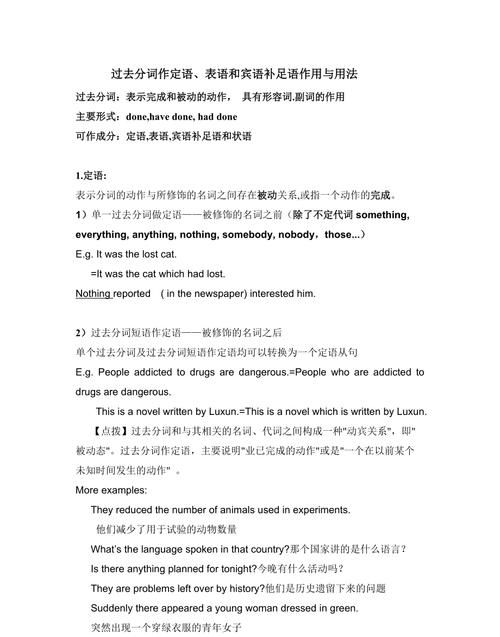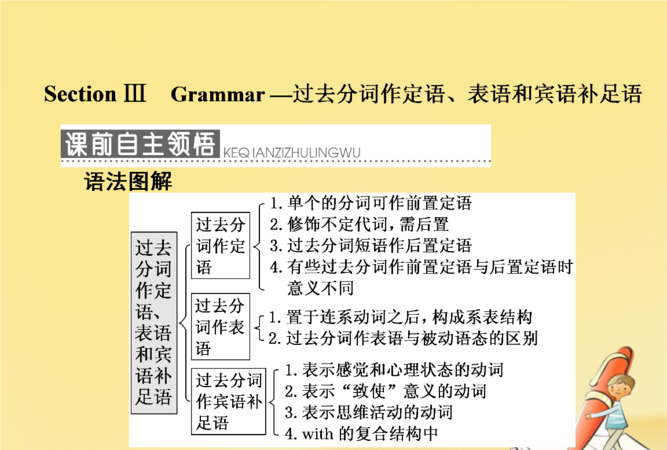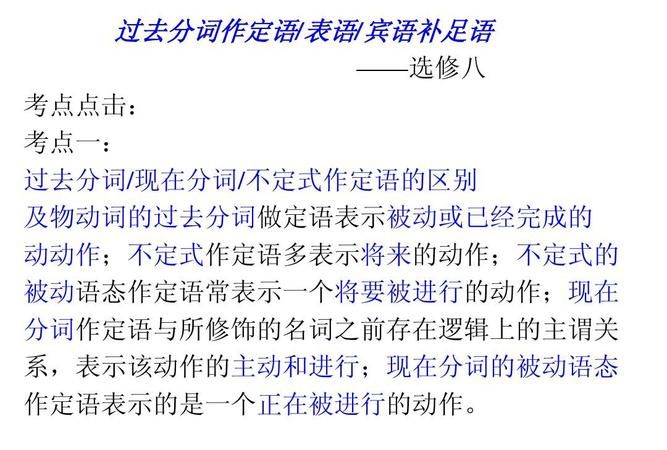本文目录
过去分词作定语的用法总结
1.作前置定语:过去分词用作定语,如果是单个的,置于其所修饰的名词之前。
2.作后置定语过去分词短语用作定语时,置于其所修饰的名词之后,其意义相当于一个定语从句,但较从句简洁,多用于书面语中。
3.作非限制性定语。

什么是过去分词作定语
过去分词作定语有前置和后置两种情况。
1、前置定语
单个的过去分词作定语,通常放在被修饰的名词之前,表示被动和完成意义。
A类:被动意义:
an honored guest 一位受尊敬的客人
The injured workers are now being taken good care of in the hospital.
受伤的工人现正在医院受到良好的照料。
B类:完成意义:
a retired teacher 一位退休的教师
They are cleaning the fallen leaves in the yard.
他们正在打扫院子里的落叶。
2、后置定语
过去分词短语作定语时,通常放在被修饰的名词之后,它的作用相当于一个定语从句。如:
This will be the best novel of its kind ever written (=that has ever been written).
这将是这类小说中写得最好的。
Who were the so-called guests invited (=who had been invited) to your party last night?
昨晚被邀请参加你的晚会的那些所谓的客人是谁呀?
过去分词作表语
作表语的过去分词主要来自及物动词,在主-系-表句型中,说明主语所处的一种状态。其中系动词有包括be在内的多种形式。如:
You seem frightened.
你看样子受了惊吓。
少数不及物动词(如go, come, set)的过去分词也能作表语,但它们不表示被动意义,只是表示动作完成。如:
They are gone for vacation.
他们度假去了。
注意:要区别“系动词+过去分词(系表结构)” 和 “系动词+过去分词(被动语态)”。如:
A. The library is now closed.
图书馆现在关门了。
B. The library is closed at six.
图书馆经常在六点钟关门。
说明:作表语用的过去分词表示主语的特点或所处的状态,强调主谓关系。这种结构中的过去分词前可加quite, very, rather等修饰词。系动词可有多种,表示不同的意义;被动语态表示动作,强调动宾关系,绝大多数被动结构中的行为执行者还可以用by短语来表示。因此,我们不难看出在上面两句中,A句是系表结构,B句是被动语态。
分词详解:过去分词作定语 与其修饰的词是被动关系,相当于一个被动语态的定语从句。 9.1 分词作定语
分词前置
We can see the rising sun. 我们可以看到东升的旭日
He is a retired worker. 他是位退休的工人
分词后置 (i.分词词组;ii. 个别分词如given, left; iii. 润色不定代词 something等)
There was a girl sitting there. 有个女孩坐在那里
This is the question given. 这是所给的问题
There is nothing interesting. 没有有趣的东西
过去分词作定语
与其修饰的词是被动关系,相当于一个被动语态的定语从句。
Most of the people invited to the party were famous scientists.
Most of the artists invited to the party were from South Africa.
范例例题
1) The first textbook ___ for teaching English as a foreign language came out in the 16th century.
A. have written B. to be written C. being written D. written
答案D. 书与写作是被动关系,利用过去分词做定语表被动,相当于定语从句 which is written
2)What's the language ____ in Germany?
A. speaking B. spoken C. be spoken D. to speak
答案B. 主语language与谓语动词之间有被动的含义。
spoken是动词speak的过去分词情势,在句中作定语,修饰主语 language, spoken 与 language有被动关系。该句可以了解为:
What's the language (which is) spoken in German?
9.2 分词作状语
As I didn't receive any letter from him, I gave him a call.
-> Not receiving any letter from him, I gave him a call.
由于没有收到他的信,我给他打了电话。
If more attention was given, the trees could have grown better.
-> Given more attention,the trees could have grown better.
假如多给些照应,那些树会长得更好。
范例例题
1) _____ some officials, Napoleon inspected his army.
A. Followed B. Followed by C. Being followed D. Having been followed
答案B. Napoleon 与follow 之间有被动的含义。being followed除表达被动之外,还有动作正在进行之意。 followed by (被…追随)。本题可改为: With some officials following, Napoleon inspected his army.
2)There was a terrible noise ___ the sudden burst of light.
A. followed B. following C. to be followed D. being followed
答案B. 由于声音在闪电后,因此为声追随着光,声音为追随的发出者,为主动 。用现在分词。
3) _______, liquids can be changed into gases.
A. Heating B. To be heated C. Heated D. Heat
答案C. 本题要选一分词作为状语。现在分词表主动 ,正在进行的;过去分词表被动的,已经完成的。对于液体来说是加热的受动者,是被动的,因而选C。它相当于一个状语从句 When it is heated,…
注意: 选择现在分词还是过去分词,要害看主句的主语。如分词的动作是主句的主语发出,分词就选用现在分词,反之就用过去分词。
(Being ) used for a long time, the book looks old.
由于用了很长时间,这本书看上去很旧。
Using the book, I find it useful.
在应用的历程中, 我创造这本书很有用。
9.3 连词+分词(短语)
有时为使分词短语与主句关系更明确,可在分词前加连词。 连词有: when,while,if though,after, before, as. 但分词的主语和主句的主语必须为同一个,如:
While waiting there, he saw two pretty girls come out of the building.
waiting 和saw 的主语雷同。
9.4 分词作补语
通常在感官动词和使役动词之后,如:
I found my car missing. 我发信我的车不见了。
I'll have my watch repaired. 我想把我的手表修一下。
9.5 分词作表语
现在分词: 表现主动 ,正在进行
过去分词: 表现被动,已经完成
She looked tired with cooking. 她由于忙着做饭,看上去有些疲惫。
He remained standing beside the table. 他依然站在桌旁。
9.6 分词作插入语
其结构 是固定的,意思上的主语并不是句子的主语。
generally speaking 一般说来
talking of (speaking of) 说道
strictly speaking 严峻的说
judging from 从…确定
all things considered 从整体来看
taking all things into consideration 全面看来
Judging from his face, he must be ill. 从他的脸色看,他必然是病了。
Generally speaking, dogs can run faster than pigs. 总的来说,狗比猪跑得快。 (speaking 并不是dogs 的动作)
9.7 分词的时态
1)与主语动词同时,
Hearing the news, he jumped with joy. 听到这一消息 ,他兴奋得手舞足蹈。
Arriving there, they found the boy dead. 刚一到那儿,他们就创造那男孩逝世了。
范例例题
The secretary worked late into the night, ___a long speech for the president.
A. to prepare B. preparing C. prepared D. was preparing
答案 B. 此处没有连词,不能选D,否则出现了两个谓语动词worked和was preparing。 只能在B,C中选一个。又因前后两个动作同时产生,且与主语为主动关系,利用现在分词。
2)先于主动 词
While walking in the garden,he hurt his leg. 在花园里溜达时他伤了腿。
分词作时间状语,如果先与主动 词的动作,且强调先后, 要用having done。
Having finished his homework, he went out.
=As he had finished his homework, he went out.
做完作业后,他出去了。
范例例题
___ a reply, he decided to write again.
A. Not receiving B. Receiving not C. Not having received D. Having not received
答案C. 本题考核分词的时态与分词的否定式。根据题意确定 ,分词的动作(接信)产生在谓语动词的动作(决心再写信)之前,因此用分词的完成式。分词的否定式的构成为not +分词,故选C。该句可了解为:Because he had not received a reply, he decided to write again.
9.8 分词的语态
1)通常,现在分词表现主动 ,过去分词表现被动,例如:
He is the man giving you the money. (= who gave you…) 他就是给你钱的那个人。
He is the man stopped by the car. ( = who was stopped by…)
他就是那个被车拦住的人。
2)不及物动词的过去分词表现动作已经产生
gone, fallen, retired, grown-up, escaped, faded, returned
例: a well-read person. 一个读过许多书的人
a much-travelled may 一个去过许多处所的人
a burnt-out match 烧完了的火柴

过去分词作定语表示什么含义
过去分词作定语,可表示被动,完成。
fallen
leaves
落叶(已经落在地下的叶子)
falling
leaves
落下的叶子(正在风中飘曳的)

以上就是关于过去分词作定语的四种含义,过去分词作定语的用法总结的全部内容,以及过去分词作定语的四种含义 的相关内容,希望能够帮到您。

